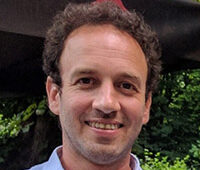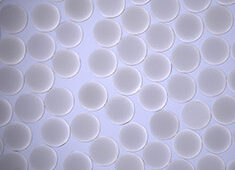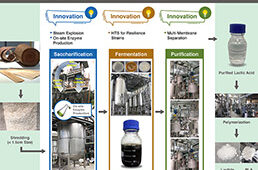 Have
Have
you seen those big, bulky, breakable photovoltaic cells that now
collect the sun’s rays? Well, what if solar energy could be harnessed
using tiny collectors that could be spray painted on a roof, a wall or
even a window?
The
science of converting sunlight into electrical energy is more than a
century old, but the reality of doing it efficiently and affordably is
ongoing.
“Not
only does it involve fundamental science in terms of physics and
chemistry, and in some cases biology, but there are major engineering
challenges as well,” notes Brian Korgel, a nanomaterials chemist at the
University of Texas at Austin.
Korgel and his colleagues are a new breed of chemical engineers, looking for answers to the world’s big problems.
“There
was a time where the field of chemical engineering had a reputation of
being really conservative. You’d get your degree in chemical
engineering, and you’d work for a chemical plant with a hard hat or in a
giant refinery,” says Korgel.
That’s no longer the only option.
“Chemical
engineers are now able to take these new chemicals, like nanomaterials,
and we’re trying to create the technologies that can meet the global
challenge of, say, energy sustainability. We’re taking chemistry, we’re
inventing new ways to actually make materials that can’t be made any
other way,” he continues.
With
support from the National Science Foundation (NSF), that’s what Korgel
and his team are doing to create solar cells that are light, flexible,
efficient and–often the biggest obstacle–affordable.
 “It’s
“It’s
challenging to get high efficiencies of conversion. For example, the
basic single junction solar cell is fundamentally limited to an
efficiency of 30 percent. So, if you made a perfect solar cell, the
highest efficiency would be 30 percent,” explains Korgel at his Austin
lab.
Currently,
manufacturing cells with anything near that level of efficiency
requires high heat, a vacuum and is very expensive. Korgel’s approach,
using nanotechnology, is completely different.
“What
we’re doing right now in my research group is making nanocrystals.
We’re focused on ‘CIGS’–copper, indium, gallium, selenide–and we make
small particles of this inorganic material that we can disperse in a
solvent, creating an ink or paint,” he says.
This
solar “paint” would have the same function as the large photovoltaic
(PV) solar collectors on buildings and “solar farms” around the world.
Korgel describes the tiny collection devices as a “solar sandwich.”
“So
these devices are ‘sandwiches,’ where you have the metal contact on the
bottom and metal contact on the top to extract the charge out; and the
middle part is the part that absorbs out the light,” explains Korgel.
This paint, made of the CIGS nanocrystals, can be sprayed on plastic, glass and even fabric to create a solar cell.
“So
what we’re able to do is create radically new ways of depositing
inorganic films to make solar cells, and so we’re trying to meet this
challenge of much lower cost of manufacturing,” he says.
One
way to create these cells on a very large scale would be to print them
on thin, flexible sheets, the same way huge presses now print
newspapers. “And the final product would ideally look something like
today’s shingles,” says Vahid Akhavan, one of Korgel’s graduate research
assistants. “You want to produce something that is very user friendly.
So you could go to your local hardware store, buy them and install them
on your roof.”
These
shingles would do double duty, generating electricity while serving as
roofing material. They would be also stand up better in bad weather,
such as hail and windstorms, than some of today’s more fragile solar
collectors.
A
lot of challenges need to be conquered before solar energy becomes so
commonplace. High on that list is improving the efficiency of these
nanomaterial cells. “Right now, we have made devices that have an
efficiency of 3 percent, and to be commercial, you really need to be at
10 percent,” says Korgel. “But I think we can get to 10 percent. Those
are just engineering challenges; they are not necessarily easy, but they
are not fundamental roadblocks.”
Depending on what part of the world is looking to transition to solar energy, that improved efficiency is critical.
“I
did my post-doc in Dublin, Ireland, so I know cloudy days with five
hours of sunlight,” says Korgel. “So if you want to use solar, you need
to have efficient devices that can harvest the sun under those
conditions.”
Another
obstacle will be determining what raw materials can be used if this
technology can be mass produced. The copper, indium, gallium, and
selenide are not all cheap or readily available.
“Ultimately,
thinking much further out, you want to go with a technology where you
use elements that are earth-abundant,” says Korgel.
One
possibility is silicon, which is made from sand, abundant across our
planet. But extracting the silicon from the sand is now an incredibly
energy-intensive process and the chemicals it takes to do that are
pretty harsh on the environment.
Korgel,
his students and colleagues see all those problems as having answers.
And he’s also motivated by non-scientists eager to wean the world from
diminishing fossil fuels.
“Everyone
realizes this is a major problem, and so many people want to see it
solved and are incredibly enthusiastic and supportive of the scientific
and engineering community. And it’s inspiring,” says Korgel. “What it’s
given me is a deep appreciation of how important this problem of meeting
energy sustainability is. It drives you further on to try and meet that
need.”
The
Korgel lab is also investigating medical uses for nanomaterials. “These
nanomaterials have unique properties. They might be fluorescent and
give off light, they can be magnetically responsive. If you shine light
on them, they can generate heat. So you can take all of these unique
properties, and then they’re so small that they can flow around in your
bloodstream and get into organs,” he says.
For
example, a nano probe could detect a cancer cell and then deliver the
medicine to kill it. “So, if you could come up with a nanoscopic unit
that could detect a variety of different types of cancers or different
diseases and then carry out a therapy of some sort, that would be a big
deal,” he says.




